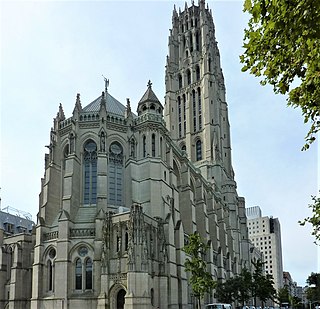
Riverside Church is an interdenominational church in the Morningside Heights neighborhood of Manhattan in New York City, United States. The church is associated with the American Baptist Churches USA and the United Church of Christ. It was conceived by philanthropist businessman and Baptist John D. Rockefeller Jr. in conjunction with Baptist minister Harry Emerson Fosdick as a large, interdenominational church in Morningside Heights, which is surrounded by academic institutions.

Metropolitan United Church is a historic Neo-Gothic style church in downtown Toronto, Ontario, Canada. It is one of the largest and most prominent churches of the United Church of Canada. It is located at 56 Queen Street East, between Bond and Church streets, in Toronto's Garden District.

Second Presbyterian Church is a landmark Gothic Revival church located on South Michigan Avenue in Chicago, Illinois, United States. In the late nineteenth and early twentieth centuries, some of Chicago's most prominent families attended this church. It is renowned for its interior, completely redone in the Arts and Crafts style after a disastrous fire in 1900. The sanctuary is one of America's best examples of an unaltered Arts and Crafts church interior, fully embodying that movement's principles of simplicity, hand craftsmanship, and unity of design. It also boasts nine imposing Tiffany windows. The church was listed on the National Register of Historic Places in 1974 and later designated a Chicago Landmark on September 28, 1977. It was designated a National Historic Landmark in March 2013.

Kirk in the Hills Presbyterian (1958) is a church located in Bloomfield Township, Michigan.
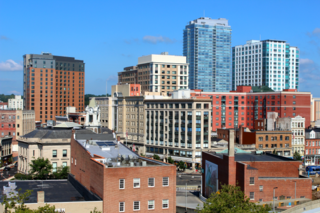
Downtown Stamford, or Stamford Downtown, is the central business district of the city of Stamford, Connecticut, United States. It includes major retail establishments, a shopping mall, a university campus, the headquarters of major corporations and Fortune 500 companies, as well as other retail businesses, hotels, restaurants, offices, entertainment venues and high-rise apartment buildings.

In 2017, the City of Stamford established the Stamford Arts and Culture Commission to help bolster arts and tourism in the city.

The Cathedral Basilica of Christ the King is a Roman Catholic church in Hamilton, Ontario, Canada. The cathedral was consecrated on December 19, 1933. It is the seat of the bishop of the Diocese of Hamilton, and the cathedral of the Diocese of Hamilton. The cathedral contains the cathedra of the bishop, the Most Rev. Douglas Crosby. The cathedral was raised to the status of a minor basilica in February 2013 by Pope Benedict XVI.

Government Street Presbyterian Church in Mobile, Alabama is one of the oldest and least-altered Greek Revival church buildings in the United States. The architectural design is by James Gallier Sr., James H. Dakin, and Charles Dakin. The trio also designed Barton Academy, four blocks down Government Street to the west. Government Street Presbyterian reflects the influences of Ithiel Town, Minard Lafever, and Andrew Jackson Downing. It was declared a National Historic Landmark in 1992.

The National Presbyterian Church is a Christian congregation of approximately 1,500 members of all ages from the greater metropolitan Washington, D.C. area. The mission statement of the church is "Leading People to Become Faithful Followers of Jesus Christ Together in God's World"

The Cathedral of St. John the Evangelist in Spokane, Washington, is the cathedral church of the Episcopal Diocese of Spokane. Three Spokane parishes, All Saints Cathedral, St. Peter's, and St. James, merged on October 20, 1929, to form the Cathedral of St. John the Evangelist. Construction began on the present cathedral four years previous in 1925 and was structurally completed in less than a generation under the supervision of founding architect Harold C. Whitehouse of the Spokane firm of Whitehouse & Price. It is located in the Rockwood neighborhood on Spokane's South Hill.
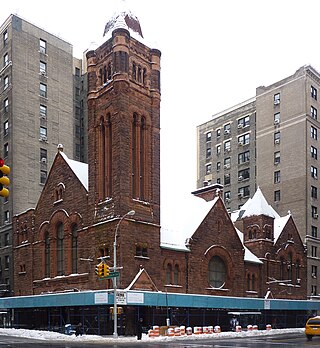
West-Park Presbyterian Church is a Romanesque Revival Presbyterian church located on the corner of Amsterdam Avenue at 86th Street on the Upper West Side of Manhattan in New York City. It consists of a main sanctuary and chapel.

The Grosse Pointe Memorial Church (GPMC) is a church located at 16 Lake Shore Drive in Grosse Pointe Farms, Michigan, USA. it is a member of the Presbyterian Church, USA (PCUSA). It was designated a Michigan State Historic Site in 1990 and listed on the National Register of Historic Places in 1993.
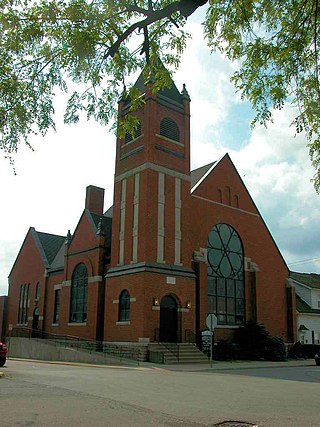
The First Presbyterian Church of Hartford City is a Presbyterian church in Hartford City, Indiana, United States. The edifice is the oldest church building in a small city that at one time was a bustling community with as many as ten glass factories – and over 20 saloons. Located at the corner of High and Franklin Streets, the church is part of the Hartford City Courthouse Square Historic District. The church was added to the National Register of Historic Places in 1986.
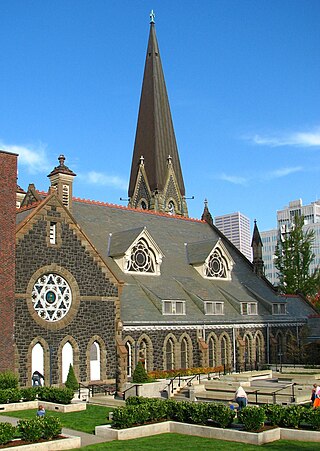
The First Presbyterian Church is a church building located in downtown Portland, Oregon, that is listed on the National Register of Historic Places. Construction began in 1886 and was completed in 1890. The building has been called "one of the finest examples" of High Victorian Gothic architecture in the state of Oregon. It includes stained-glass windows made by Portland's Povey Brothers Art Glass Works and a church bell cast with bronze from captured Civil War cannons.

St Nicholas Church is an active Anglican parish church in the diocese of Chester on Newport Avenue, in Wallasey, in Wirral, England. It was designed by J. F. Doyle and built in 1910–11. The church is located near Wallasey Golf Club and is known as the Harrison Memorial Church or the Golfers' Church. It is recorded in the National Heritage List for England as a designated Grade II listed building.

St Paul's Presbyterian Church is a heritage-listed Presbyterian church at 43 St Pauls Terrace, Spring Hill, City of Brisbane, Queensland, Australia. It was designed by Francis Drummond Greville Stanley and built from 1887 to 1889 by Thomas Rees. It was added to the Queensland Heritage Register on 21 October 1992.
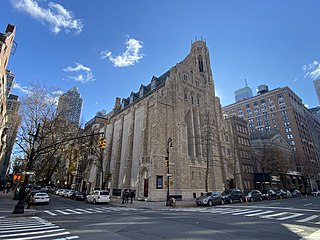
Central Presbyterian Church is a historic congregation on the Upper East Side of Manhattan in New York City, founded by pastor and abolitionist William Patton in 1821. It is a member of the Evangelical Presbyterian Church, and it worships in a Gothic Revival structure completed in 1922 that was originally commissioned and largely funded by John D. Rockefeller Jr. as Park Avenue Baptist Church.

St Andrew's Church is a heritage-listed Seventh Day Adventist Church church at the corner of Maryborough and Woongarra Streets, Bundaberg Central, Bundaberg, Bundaberg Region, Queensland, Australia. It was designed by Lange Leopold Powell and built from 1931 to c. 1940. It was added to the Queensland Heritage Register on 3 August 2004.
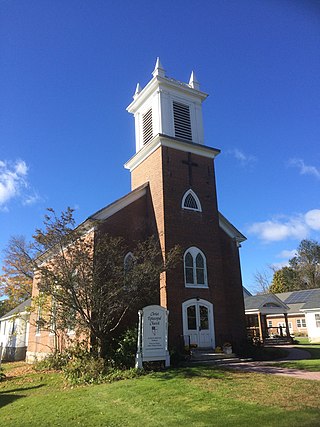
Christ Episcopal Church is a historic Episcopal church located on the town green of Bethlehem, Connecticut, United States. Founded as a parish early in the 19th century, it has been a central part of the life of the town ever since. The building is an outstanding example of Gothic Revival architecture, and its unique metal roof helps incorporate it visually with other historic buildings in the area around the green. Major renovations were designed by R. W. Hill, a noted Waterbury architect, early in his career. It also houses a Jardine tracker organ designed in 1855. Along with the First Congregational Church across the street and the Bellamy-Ferriday House on another side of the town green, Christ Episcopal Church helps anchor the historic center of this small rural town in Litchfield County, Connecticut.






















